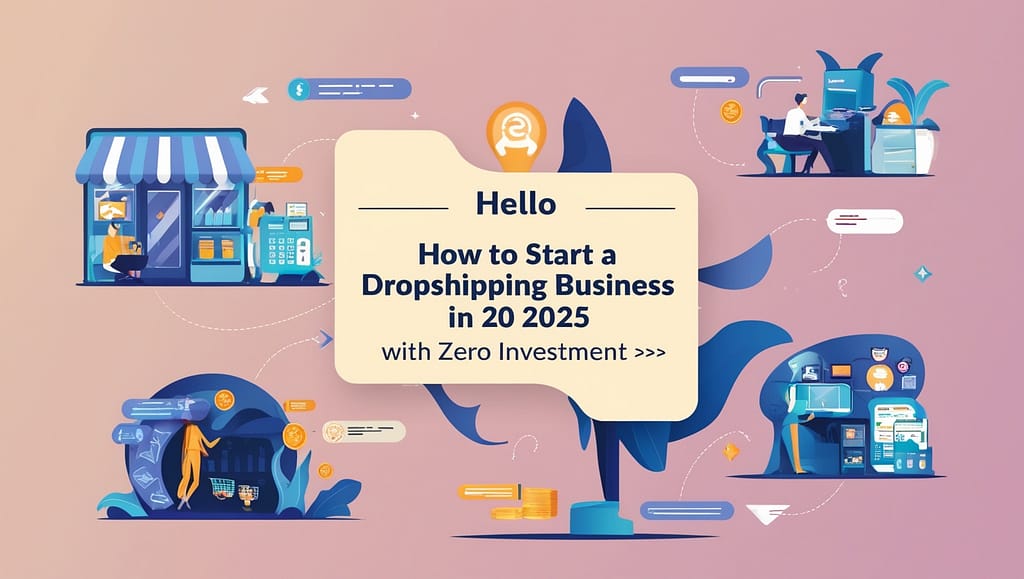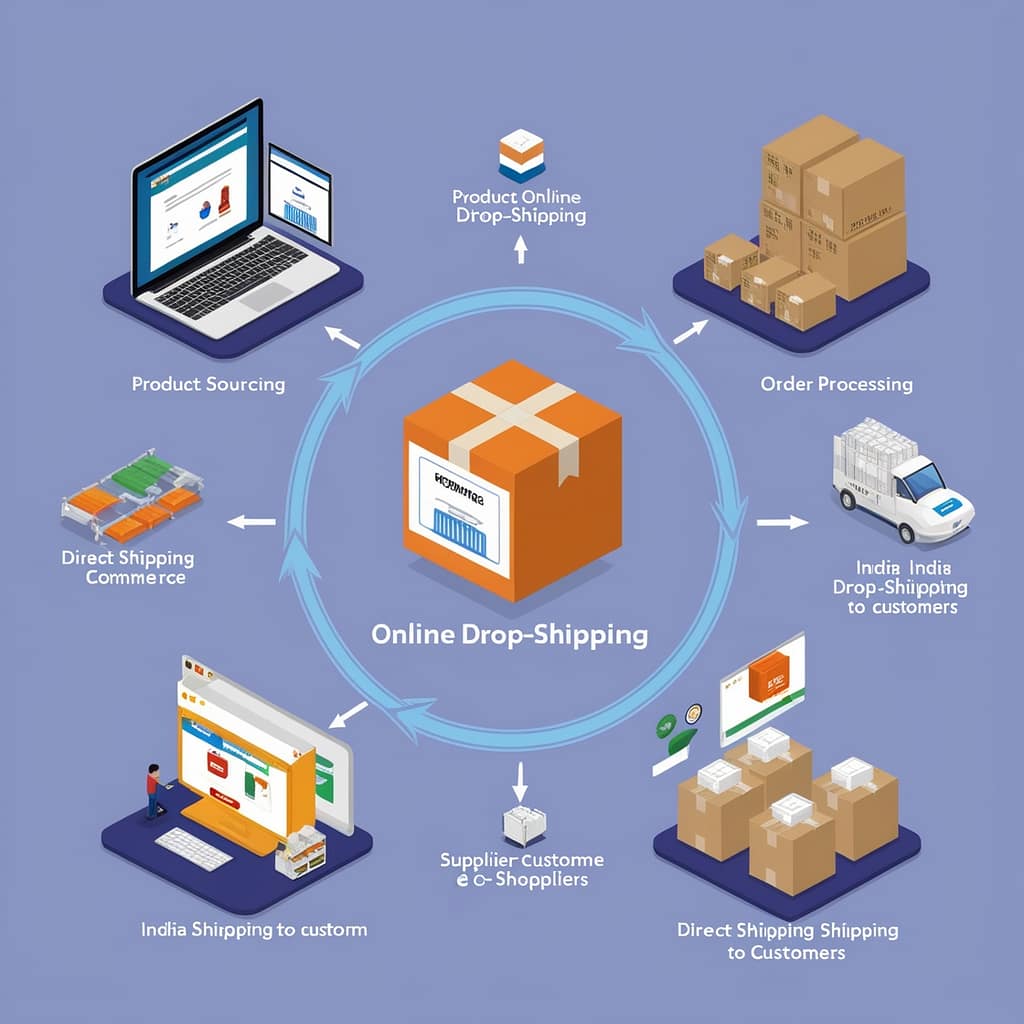
Introduction
In the rapidly evolving digital marketplace of 2025, dropshipping remains one of the most accessible entrepreneurial opportunities, particularly for those looking to start a business with no initial capital. As a model requiring no upfront inventory, minimal technical expertise, and global scalability, it appeals to aspiring business owners across various demographics. This guide provides a rigorous framework for establishing a zero-investment dropshipping business, emphasizing strategic innovation, resource optimization, and market adaptability.
Dropshipping thrives on the intersection of e-commerce advancements and consumer convenience. As online retail continues its exponential growth, businesses employing this model can capitalize on shifting consumer preferences and technological integration to carve out sustainable niches.
Table of Contents
Defining Dropshipping: A Model of Operational Efficiency
Dropshipping is a retail fulfillment strategy where sellers act as intermediaries between customers and suppliers. Sellers market products without physically stocking inventory, while suppliers handle logistics such as storage, packaging, and shipping.
Core Advantages of Dropshipping:
- Negligible Startup Costs: Eliminates the financial burden of inventory procurement.
- Operational Agility: Enables entrepreneurs to operate from any location with internet access.
- Scalable Growth: Facilitates seamless product portfolio expansion without additional infrastructure.
- Market Versatility: Supports diverse product offerings, catering to varied consumer demands.
- Risk Mitigation: Reduces exposure to financial losses associated with unsold inventory.
Structural Dynamics:
- The seller’s role is predominantly in marketing and customer relationship management.
- Effective business outcomes hinge on supplier reliability and digital marketing acumen.
- Automation platforms optimize operational efficiency, allowing greater focus on business scaling.
Comprehensive Guide to Initiating a Dropshipping Business in 2025
1. Market Research and Niche Selection
Strategic niche identification is the cornerstone of a successful dropshipping enterprise. It ensures alignment with consumer demand and mitigates competitive saturation.
Criteria for Niche Viability:
- Problem-Solving Potential: Products addressing specific pain points (e.g., posture-correcting chairs for remote workers).
- Audience Breadth: Items with cross-demographic appeal.
- Competitive Positioning: Favor niches with moderate competition and high differentiation potential.
High-Growth Niches in 2025:
- Sustainability-driven products
- Home automation technologies
- Wellness and fitness equipment
- Customizable merchandise
- Pet-focused innovations
2. Establishing Supplier Partnerships
Collaborating with reliable suppliers is pivotal to operational success. Suppliers influence product quality, shipping timelines, and customer satisfaction.
Leading Platforms for Supplier Collaboration:
- AliExpress: A global repository of diverse product categories.
- Meesho: Ideal for localized Indian markets.
- GlowRoad: Streamlined for Indian entrepreneurs, emphasizing affordability and usability.
Evaluative Considerations:
- Shipping logistics and timeline transparency.
- Custom branding opportunities.
- Return policy frameworks.
- Inventory synchronization.
3. Selecting an E-commerce Platform
Choosing an optimal platform ensures streamlined store management and customer engagement. Free or low-cost platforms are ideal for zero-investment setups.
Platform Recommendations:
- Shopify Lite: Offers beginner-friendly tools with minimal fees.
- WooCommerce: Tailored for WordPress users seeking customization.
- Meesho Reselling App: Simplifies operations for first-time entrepreneurs in India.
4. Constructing Your Digital Storefront
A compelling online storefront enhances credibility and user retention. Effective store design integrates aesthetics with functionality.
Key Steps:
- Theme Selection: Use cost-free, responsive themes like Astra or Dawn.
- Brand Identity: Leverage Canva for logo and graphic creation.
- Content Optimization: Write persuasive, SEO-optimized product descriptions.
- Multimedia Integration: Utilize professional-grade visuals and demo videos.
- Mobile Responsiveness: Prioritize user-friendly mobile interfaces.
5. Implementing No-Cost Marketing Tactics
Resource-efficient marketing amplifies visibility and customer acquisition. Consistent execution of these strategies fosters sustainable growth.
Social Media Marketing:
- Develop platform-specific content (Instagram reels, Pinterest pins).
- Optimize discoverability with targeted hashtags (e.g., #EcoDropshipping, #TopTrends2025).
- Engage in niche communities to build organic visibility.
Content Marketing:
- Launch an informational blog addressing customer pain points.
- Publish data-driven articles enriched with keywords for SEO.
- Partner with micro-influencers for authentic endorsements.
Email Campaigns:
- Utilize platforms like Mailchimp to send newsletters and promotions.
- Incentivize sign-ups with downloadable resources or exclusive discounts.
6. Operational Automation for Enhanced Efficiency
Automation facilitates scalable growth by reducing manual intervention in repetitive tasks.
Recommended Tools:
- DSers: Automates order processing for AliExpress.
- Grammarly: Ensures polished, error-free communication.
- Hootsuite: Schedules and monitors social media campaigns.
- Google Sheets: Simplifies data tracking and inventory management.
Case Study: Ramesh’s Entrepreneurial Success
Ramesh, an educator from rural India, initiated his dropshipping journey in 2023. By targeting eco-conscious consumers and employing social media-driven marketing strategies, he achieved a monthly revenue of ₹25,000 within six months. Ramesh utilized platforms like Canva for branding, DSers for streamlined logistics, and Facebook groups for community engagement.
Key Insights from Ramesh’s Strategy:
- Identify and engage niche-specific audiences.
- Optimize cost structures with free tools.
- Establish a robust customer communication framework.
Conclusion
The dropshipping business model exemplifies the confluence of innovation and accessibility. With strategic planning, resourceful execution, and a commitment to excellence, entrepreneurs can harness its potential to achieve remarkable outcomes. Begin your journey today by identifying a viable niche, leveraging technological tools, and engaging customers authentically.
Frequently Asked Questions
1. Is zero-investment dropshipping feasible?
Absolutely. By leveraging free platforms and marketing strategies, you can minimize financial entry barriers.
2. What revenue can I expect initially?
Earnings vary by niche and marketing effectiveness, with beginners averaging ₹20,000–₹50,000 per month.
3. What challenges might I face?
Delayed supplier shipments.
Customer grievance resolution.
Maintaining competitive pricing.
4. Are there regulatory requirements in India?
Dropshipping is legal in India. Compliance with GST regulations is mandatory for turnovers exceeding ₹40 lakh.

